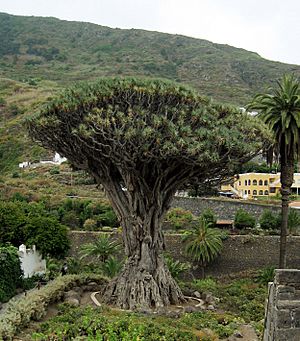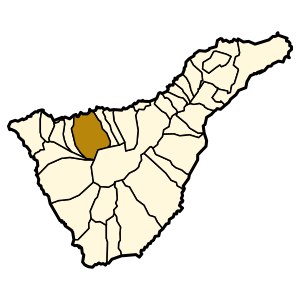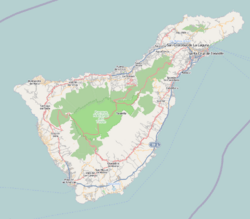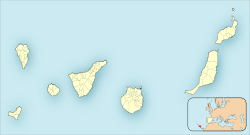Icod de los Vinos facts for kids
Quick facts for kids
Icod de los Vinos
|
|||
|---|---|---|---|
|
Municipality
|
|||

|
|||
|
|||

Municipal location in Tenerife
|
|||
| Country | |||
| Autonomous Community | |||
| Province | Santa Cruz de Tenerife | ||
| Island | Tenerife | ||
| Area | |||
| • Total | 95.9 km2 (37.0 sq mi) | ||
| Elevation
(AMSL)
|
235 m (771 ft) | ||
| Population
(2018)
|
|||
| • Total | 22,749 | ||
| • Density | 237.22/km2 (614.4/sq mi) | ||
| Time zone | UTC±0 (WET) | ||
| • Summer (DST) | UTC+1 (WEST) | ||
| Postal code |
38430
|
||
| Area code(s) | +34 (Spain) + 922 (Tenerife) | ||
| Climate | BSh | ||
| Website | www.icoddelosvinos.es | ||
Icod de los Vinos is a lovely town and municipality in the Canary Islands of Spain. It's located on the island of Tenerife, in the northwestern part. People from Icod are called "icodenses" in Spanish.
This municipality covers about 95.9 square kilometers (37 square miles). It sits at an altitude of 235 meters (771 feet) above sea level. In 2022, about 23,496 people lived there.
Contents
Exploring Icod de los Vinos
Icod de los Vinos is built on a gentle slope that goes from thick Canary Island Pine forests all the way down to the sea. It has almost 10 kilometers (6 miles) of coastline! The town is surrounded by a very rich valley. From its streets, you can see the huge volcanic mountain Teide. You can also see dense pine forests that stretch from the mountain's top down to Icod's higher areas.
The area is known for its banana farms, orchards, and vineyards. This makes for a busy local trade. The valley is so fertile and good for farming that the town's full name, Icod de los Vinos, means "Icod of the Wines." Icod de los Vinos is about 47 kilometers (29 miles) west of Santa Cruz de Tenerife, the capital city.
History of Icod
Icod de los Vinos was founded in 1501. It's a town full of old, grand houses, palaces, churches, and convents. The name "Icod" comes from an old local kingdom called Icoden. "Vinos" means "wines" in Spanish, referring to the local wine. When the Spanish arrived, they quickly settled this fertile area. They started growing sugarcane and grapevines, with grapevines becoming the most important crop.
Famous Landmarks and Sights
In the Plaza de Lorenzo Cáceres, you'll find a monument to General José Antonio Páez. He was a founder of Venezuela's independence, and his family came from Icod. The town has many small chapels and buildings that show its rich history and art. You can see some of these treasures at the Museo de Arte Sacro (Museum of Sacred Art) in the Church of San Marcos.
The Ancient Dragon Tree
In Parque del Drago, near the Church of San Marcos, stands a very famous dragon tree. It's about 22 meters (72 feet) tall and its lower trunk is 10 meters (33 feet) wide! It's thought to weigh around 70 tons. This tree is often said to be a thousand years old, which is why it's called El Drago Milenario (The Thousand-Year-Old Dragon). While its exact age is hard to know, it has been a symbol of Icod for a very long time.
Church of San Marcos
The Church of San Marcos (St. Mark) is located in the Plaza de Lorenzo Cáceres. People believe that before the Spanish conquest, the native Guanches already honored a small statue of St. Mark here. This church is built in the traditional Canary Islands style. It has a beautiful stone bell tower and facade. Inside, you can see important statues, like those of St. Mark the Evangelist and Our Lady of the Kings.
Plaza de La Pila
The Plaza de La Pila is close to the Parque del Drago. It's surrounded by grand old homes, including the Casa de los Cáceres (house of the Cáceres family), which is now a museum. The plaza itself has a small botanic garden, making it a peaceful and pretty spot.
Playa de San Marcos
This sheltered bay on the north coast of Tenerife is named after the image of St. Mark. This image was found in a cave near the seashore during the island's conquest. Because this harbor is safe from most winds and has good places to anchor, sailors have used it as a refuge for centuries. Today, Playa de San Marcos is a popular spot for relaxing. It has black sand, which is common in northern Tenerife, and is protected by shell-shaped cliffs.
Cueva del Viento
The Cueva del Viento (Cave of the Wind) is believed to be the largest volcanic cave in the world! It's a complex lava tube system that stretches over 17 kilometers (10.5 miles). It has many different sections and unique rock formations. This cave is also home to special animals, some of which are found nowhere else. It's a truly amazing natural wonder.
Casa de Los Cáceres
This building used to be the home of Lorenzo Cáceres, an important military officer. It has a beautiful three-story front with traditional windows. There's a large arched entrance with a stone frame and a pretty hidden balcony. It's a great example of old architecture in Icod.
Icod Public Library
The Icod Public Library is located in the San Francisco convent. It has a large collection of books, with nearly 13,200 volumes. The library also has a special collection of Canary Island art and publications. These are short books that share amazing art, literature, and writings from the Canary Islands and Spain.
Fun Traditions and Festivals
Icod de los Vinos has many unique and exciting traditions!
Tablas de San Andrés
Every year on November 29th, the day before San Andrés' day, there's a special festival for new wine. Wineries open their doors for everyone to taste the year's fresh wine, along with roasted chestnuts. The most exciting part is sliding down the steep streets on "tablas" or boards! Young people bravely steer these slippery boards down the hills. This tradition started from the old way of transporting wood down the mountain for building ships and crafts.
Los Hachitos
Los Hachitos (meaning "the little torches") is an old festival that celebrates the summer solstice. On June 23rd, the eve of St. John the Baptist's festival, people carry or throw torches. These torches are made of rags soaked in oil. Some are placed in high areas to form pictures of light like stars or hearts. Others are thrown down the mountain to look like flowing lava. It's a magical and colorful sight!
El Diablo y La Diabla
This tradition, meaning "The Devil and The She-Devil," used to be common during the Corpus Christi festival. It showed a fight between evil forces and the archangel Saint Michael. The devils, along with giants and dwarves, would entertain the town with music. Even though this custom was once forbidden, it still happens today! In mid-September, the devils appear in the Las Angustias neighborhood to honor the Virgin Mary.
Los Guanches de La Candelaria
In the area called La Candelaria, every August 15th, there's a procession for the Virgin Mary. During this, local people dress up as Guanches, the native people of the Canary Islands. They act out the first meeting between the Guanches and the Virgin. After this special performance, everyone joins the procession and enjoys a display of fireworks.
The Pilgrimage of the Poleo
In El Amparo, during the patron saint's festival in early August, there's a pilgrimage with traditional music. People go to the mountain to collect branches and a plant called poleo to decorate the neighborhood. The church's main door is decorated with an enormous sponge cake called "bollo." It's covered with small sugar figures and colorful ribbons. The rest of the arch is decorated with palm leaves, poleo, and baskets of fruit. Large bread figures called "madamas," dressed in bright colors, hang from the roof corners.
Baskets and Pastries of Santa Bárbara
In August, for St. Barbara's festival, there's a unique fair of baskets and pastries. People create amazing displays using fruits and vegetables in baskets. These are placed in the church's entrance, making the festival colorful and lively. The "pastries" are actually sugar figures shaped like animals, decorated with colorful ribbons. Single women and matchmakers carry these figures on their heads as an offering to the saint.
Delicious Icod Cuisine
Icod de los Vinos has its own special food! Some dishes can only be made here because they use ingredients found only in the Canary Islands. Canary Island food is a mix of many cultures, thanks to the islands being a busy port for centuries.
A key part of the food is los mojos, which are sauces. Mojo verde (green sauce made with cilantro) and mojo picón (a spicy sauce) are the most common. They are perfect with local fish like bogas and vieja ("old woman" fish).
Another famous dish is papas arrugadas ("wrinkled potatoes"). These are small potatoes cooked in salted water and served with their skins on. The "black" variety is considered the best.
For desserts, Icod has many tasty treats! Some popular ones include bienmesabe, arroz a la miel (honeyed rice), piononos (stuffed fried plantains), leche asada ("roasted milk"), quesadillas, and truchas (fried, filled sweet potato pastries).
Symbols of Icod
Coat of Arms of Icod de los Vinos
The town's coat of arms, given in 1921, tells a story about Icod. It features the famous Drago milenario (dragon tree) and Teide mountain. The dragon tree represents the town's welcoming people and its history. Teide symbolizes the island's strength and nobility. The coat of arms also shows eight clusters of golden grapes, representing the fertile land and wine. It also includes four figures that remind us of the island's history and the meeting of different cultures. This coat of arms shows the kindness, hard work, and strong spirit of the people of Icod.
The Flag of Icod de los Vinos
Icod de los Vinos has an official flag! It has three vertical stripes of equal width. The stripes on the sides are maroon, and the middle stripe is white. In the center of the flag is the town's coat of arms.
The colors of the flag are inspired by two important symbols of Icod: the Canary Islands Dragon Tree and Mount Teide. The maroon color represents the sap (liquid) of the ancient dragon tree. This sap was once used in medicine and is part of many old stories. The white color symbolizes the snowy peak of Mount Teide, which looks beautiful from Icod during winter.
See also
 In Spanish: Icod de los Vinos para niños
In Spanish: Icod de los Vinos para niños
Images for kids







